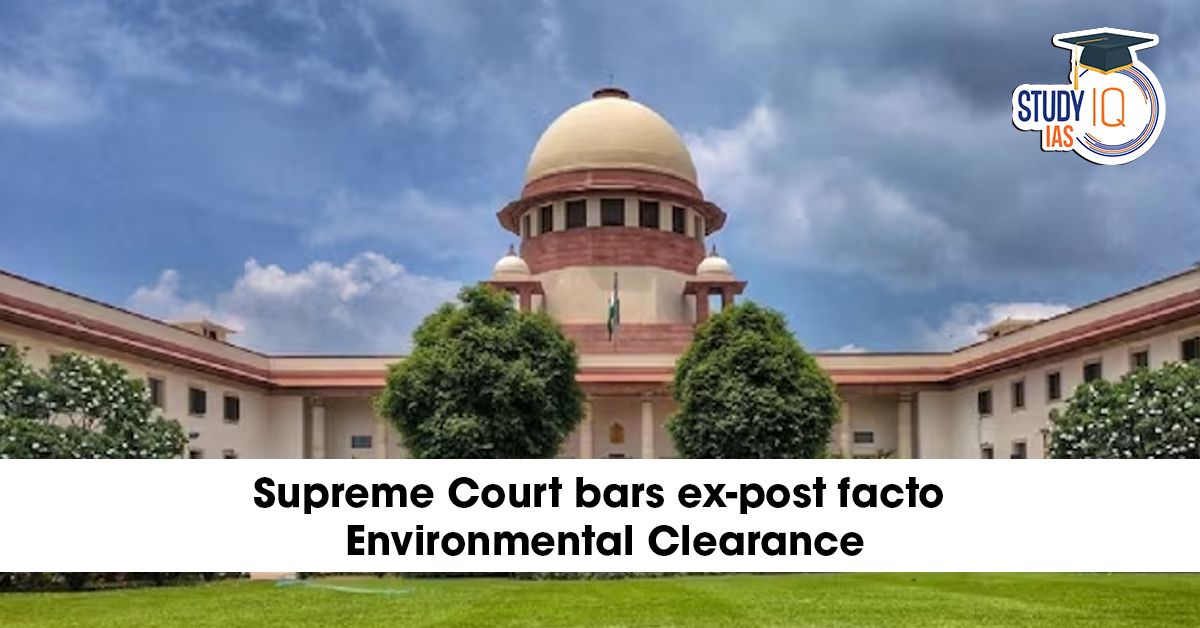Table of Contents
Context: The Supreme Court in Vanshakti vs Union of India judgement held that the 2017 notification & 2021 Order of the Ministry of Environment, Forest & Climate Change (MOEFCC) paving the way for ex-post facto or retrospective environment clearance as illegal.
SC’s Rationale for Barring Ex-post facto Environment Clearance
- Ex-post facto environment clearance regularises the illegality done by project proponents by commencing the construction or commencing the project without prior environment clearance.
- EIA notification was first issued in September 2006, thus, project proponents are fully aware of the stringent provisions of EIA, 2006 rules.
- Ex-post facto clearance will dilute the need for project proponents to take EIA clearances and cause irreparable damage to the environment.
- According to the Environment Protection Act, 1986, even after payment of penalty on the basis of the polluter pays principle for violation of EIA, the project will not be regularised. The project will have to be stopped and demolished.
- Violation of Article 21 (Right to Life), Article 14 (Right to Equality), Fundamental Duties and DPSP of the constitution, all of which cast duty on state, individuals to protect the environment.
About Environment Impact Assessment (EIA)
Convention on Biological Diversity “Environmental Impact Assessment (EIA) is a process of evaluating the likely environmental impacts of a proposed project or development, taking into account inter-related socio-economic, cultural and human-health impacts, both beneficial and adverse.”
EIA Notification 2006: Key Features
In India, EIA was formally launched as a mandatory environmental management tool introduced under the Environment Protection Act of 1986.
- Project Categorization: Projects are classified as Category A (cleared by MoEFCC) and Category B (cleared by SEIAA/SEAC).
- Category B is subdivided into B1 (EIA required) and B2 (EIA not required).
- Screening and Scoping: Projects are screened based on size and impact to determine category. Scoping defines key environmental issues and boundaries for the EIA study.
- EIA Study and Report: A detailed EIA report includes baseline data, impact assessment, alternatives, and an Environmental Management Plan (EMP) for mitigation.
- Public Consultation: Mandatory public hearings ensure community input, transparency, and stakeholder engagement in the decision-making process.
- Expert Appraisal Committees (EACs): Central and state-level EACs, comprising experts, review EIA reports and recommend project approval or rejection.
- Environment Appraisal Committee: Environmental Clearance is granted or denied by MoEFCC or SEIAA based on EAC recommendations, with conditions for environmental safeguards and monitoring.
- Post-clearance Monitoring: Project proponents must submit regular compliance reports to ensure environmental norms are followed during implementation.
- Public Access to Information: EIA documents, clearances, and monitoring data are made publicly available to promote transparency and accountability
Significance of EIA
Balancing economic development with the environment:
- Accomplishing long-term growth: E.g., Industrial projects with EIA compliance integrate eco-friendly practices, reducing future environmental costs.
- Reduced environmental damage: E.g., Highway projects may include wildlife corridors and noise barriers to protect biodiversity and human health.
- Addressing issues of affected individuals: E.g., In dam projects, local communities can raise issues related to displacement and livelihood loss.
- Preventing natural calamities: E.g., For landslide-prone areas, EIA may advise slope stabilization before approving construction.
- Builds Stakeholder Trust: E.g., Projects with strong EIA participation face less public resistance and enjoy smoother implementation.
- Minimizing judicial disputes: E.g., Mining projects with EIA-mandated water protection measures are less likely to face court challenges.
Challenges with EIA in India
- Lack of Public Awareness: E.g., In several rural dam and mining projects, locals often remain unaware of their rights under EIA provisions (CSE Report, 2021).
- Issues with EIA studies:
-
- Conflict of interest of Environment consultants: EIA studies are conducted by consultants onboarded by the project proponents, since project proponents want the project to sail through, EIA consultants often give favourable reports overlooking environmental concerns.
-
- Lack of access to baseline data: Access to good quality environmental data of a region is essential to hazard the impact a particular project will have. However, this data is not standardised and easily available.
- Ignoring Cumulative Impacts: EIAs focus on isolated projects and often neglect the combined ecological impacts of multiple developments in a region. E.g., In industrial zones like Korba (Chhattisgarh), cumulative pollution from multiple thermal plants is inadequately addressed.
- Language Barriers: EIA reports are typically available only in English or official languages. E.g., In tribal belts of Odisha and Chhattisgarh, stakeholders often cannot engage
- Corruption and Lack of Transparency: Instances of biased reporting, fraudulent public hearings, and compromised expert appraisals E.g., The CAG has flagged irregularities in several EIA clearances across states.
- Regulatory Loopholes: Vague screening criteria and project exemptions allow large developers to bypass proper scrutiny or downgrade project categories.
- Shortage of Trained Professionals: E.g., Poorly researched EIA reports have been flagged in projects like the Etalin Hydroelectric Project.
- Weak Public Participation Mechanisms: E.g., In several mining projects in Jharkhand and Andhra Pradesh, public hearings lasted less than an hour with poor attendance.
- Poor Monitoring and Enforcement: E.g., A study by the Centre for Science and Environment (2020) showed that less than 35% of cleared projects are regularly monitored.
- Attitude towards EIA: Often governments and project proponents see EIA as an obstruction to the economic development of the country. This leads to a mere tokenistic approach to EIA with both government and project proponents collaborating to bypass the provisions and overlooking nature’s interest.
Suggested Measures to Strengthen EIA
- Enhance public involvement and awareness
- Translate EIA documents into local languages for better accessibility.
- Promote transparent practices by ensuring the disclosure of relevant project informationàEncourage independent audits and public scrutiny to prevent corruption and irregularities.
- Review and revise existing EIA notifications to address gaps and exemptions, establishing a more rigorous and standardized assessment process.
- Consider the cumulative impacts of multiple projects within a region to assess their combined environmental effects.
- Invest in training programs and capacity-building initiatives for EIA professionals, including experts in environmental science, engineering, and social sciences.
- Develop robust systems for regular data collection, monitoring, and reporting.
- Impose stringent penalties for non-compliance to deter violations and encourage responsible project implementation.
- Regularly review the EIA framework to incorporate emerging best practices, scientific advancements, and lessons learned from previous experiences.


 Bonnet Macaques: Habitat, Features, Beha...
Bonnet Macaques: Habitat, Features, Beha...
 Periyar Tiger Reserve, Map, Flora, Fauna...
Periyar Tiger Reserve, Map, Flora, Fauna...
 Project Cheetah in India, Objectives, Ch...
Project Cheetah in India, Objectives, Ch...

























